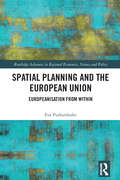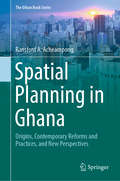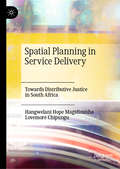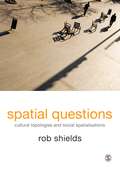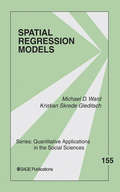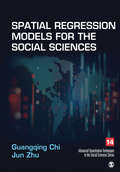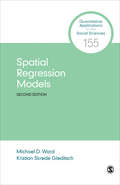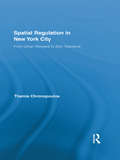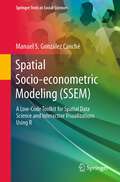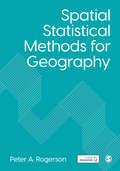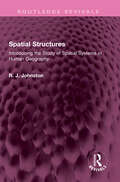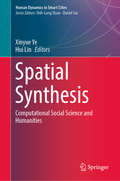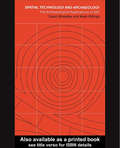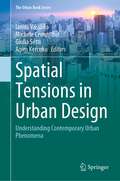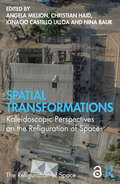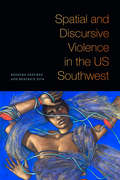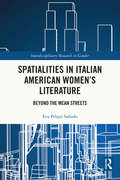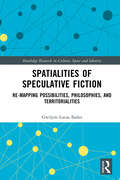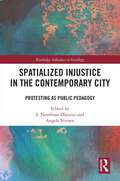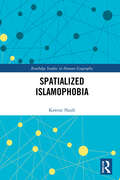- Table View
- List View
Spatial Planning and the European Union: Europeanisation from Within (Routledge Advances in Regional Economics, Science and Policy)
by Eva PurkarthoferEuropean Union policies are intertwined with all sectors of public administration and governance in the member states, including spatial, urban and regional planning. Legal regulations like the Natura 2000 Directives, funding programmes associated with EU Cohesion Policy or strategies such as the Territorial Agenda 2030 all leave their mark on planning – yet with considerably different effects in Europe’s cities and regions.This book serves as a guide to navigate the connection points between EU policies and spatial planning by introducing the logics of EU policymaking and European spatial planning, outlining the most important EU policies with relevance for spatial planning and presenting examples, from Austria and Finland, of how EU policies are applied in domestic contexts. By exploring the Europeanisation of spatial planning ‘from within’, the book acknowledges how differential ideas about what spatial planning is and what role the EU plays therein shape the actualised impacts of EU policies.By providing a comprehensive perspective on the relevance of the European Union for spatial planning, this book is ideal for students, academics and administrators who want to grasp how the EU shapes and affects planning practice in Europe’s cities and regions.
Spatial Planning in Ghana: Origins, Contemporary Reforms And Practices, And New Perspectives (The Urban Book Series)
by Ransford A. AcheampongThis book documents and analyses spatial planning in Ghana, providing a comprehensive and critical discussion of the evolving institutional and legal arrangements that have shaped and defined Ghana’s spatial planning system for more than seven decades; the contemporary policy instruments and mechanisms for articulating and implementing policies and proposals at multiple scales; and the formally established procedures for development management. It covers important themes in contemporary spatial planning discourse, including the evolving meaning, scope and purpose of spatial planning globally; the scales of spatial planning (i.e. national, regional, sub-regional and local); multi-level integration within spatial planning; public participation; the interface between urbanization, sustainable growth management and spatial planning; spatial planning and housing development; integrated spatial development and transportation planning; and spatial planning and the urban informal economy. Intended for undergraduate and graduate students, and academic researchers and practitioners/policy-makers in the multidisciplinary field of spatial planning, it appeals to readers seeking an international perspective on spatial planning systems and practices.
Spatial Planning in Service Delivery: Towards Distributive Justice in South Africa
by Hangwelani Hope Magidimisha Lovemore ChipunguThis volume presents a detailed synthesis of the historical, present-day and future state of service delivery in South Africa. The generation and distribution of services in any geographical space has been and is always a source of inequality in human society. Thus, in the context of spatial planning, space is the major factor through which distributive justice and sustainable development can be achieved. To examine the continuation of spatial inequality in service delivery, the authors employed both qualitative and quantitative research methods in a multi-pronged approach, utilizing empirical data from the Vembe District in Limpopo, data from the South African Index of Multiple Deprivation, and representative attitudinal data from the South African Social Attitudes Survey. Ultimately, this study examines spatial differences in living environments with a focus on the distribution of household services and discusses strategies to achieve spatial equality.
Spatial Politics: Essays For Doreen Massey (RGS-IBG Book Series #43)
by David FeatherstoneThis critical engagement with Doreen Massey’s ground-breaking work in geographic theory and its relationship to politics features specially commissioned essays from former students and colleagues, as well as the artists, political figures and activists whose thinking she has helped to shape. It seeks to mark and take forward her compelling contributions to geographical theorizing and political debate. High profile contributors include Lawrence Grossberg, Chantal Mouffe, Jamie Peck and Jane Wills The global reach and significance of Massey’s work recommends this volume to a diverse readership Provides an agenda for work on spatial politics and critical geography Sets out the contours of a human geography informed by Doreen Massey’s work
Spatial Questions: Cultural Topologies and Social Spatialisation
by Rob Shields"Rob Shields provides here an immensely sophisticated and detailed examination of the topological turn. He has been examining these issues for some decades and this book will surely become the standard work on cultural and spatial topology" - John Urry, Distinguished Professor, Department of Sociology, Lancaster University Our understanding of space is crucial to the way in which we understand major social problems and issues and the way we develop and maintain our worldviews. Building from a history of philosophical and geographical theories of space, Shields presents the importance of spatialisation and cultural topology in social theory and the possibilities that lie within these theoretical tools. Innovative and thought-provoking, this book goes beyond traditional ideas of spatiality and temporality to understand the multiplicity of spatialisations and relates them to everyday life.
Spatial Regression Models
by Kristian Skrede Gleditsch Michael D. WardNOTE: Updated R code for use with this volume, along with other resources, is available at: http://privatewww.essex.ac.uk/~ksg/srm_book.html Spatial Regression Models illustrates the use of spatial analysis in the social sciences. The text includes sections that cover different modeling-related topics: mapping and making projections; doing exploratory spatial data analysis; working with models which have lagged endogenous right-handed side variables; using spatial error correction models; employing conditionally autoregressive models; and dealing with over-time panels exhibiting spatial structures. Each of the modeling-based discussions includes separate delineations of how to proceed when dealing with main variables that are quantitative as well as qualitative. In each section, the authors employ prominent and diverse examples, introducing readers to key literature in the field. The examples are presented along with relevant data and programs written in the R, which illustrate exactly how to undertake the analyses described. The book ends with a chapter that covers techniques for presenting spatial information. Key Features Geared toward social science readers, unlike other volumes on this topic. Illustrates concepts using well-known international, comparative, and national examples of spatial regression analysis. Presents each example alongside relevant data and code, which is also available on a Web site maintained by the authors. Learn more about “The Little Green Book” - QASS Series! Click Here
Spatial Regression Models for the Social Sciences (Advanced Quantitative Techniques in the Social Sciences #14)
by Jun Zhu Guangqing ChiSpatial Regression Models for the Social Sciences shows researchers and students how to work with spatial data without the need for advanced mathematical statistics. Focusing on the methods that are commonly used by social scientists, Guangqing Chi and Jun Zhu explain what each method is and when and how to apply it by connecting it to social science research topics. Throughout the book they use the same social science example to demonstrate applications of each method and what the results can tell us.
Spatial Regression Models for the Social Sciences (Advanced Quantitative Techniques in the Social Sciences #14)
by Jun Zhu Guangqing ChiSpatial Regression Models for the Social Sciences shows researchers and students how to work with spatial data without the need for advanced mathematical statistics. Focusing on the methods that are commonly used by social scientists, Guangqing Chi and Jun Zhu explain what each method is and when and how to apply it by connecting it to social science research topics. Throughout the book they use the same social science example to demonstrate applications of each method and what the results can tell us.
Spatial Regression Models: Spatial Regression Models (Quantitative Applications in the Social Sciences #155)
by Kristian Skrede Gleditsch Michael D. WardSpatial Regression Models illustrates the use of spatial analysis in the social sciences within a regression framework and is accessible to readers with no prior background in spatial analysis. The text covers different modeling-related topics for continuous dependent variables, including mapping data on spatial units, creating data from maps, analyzing exploratory spatial data, working with regression models that have spatially dependent regressors, and estimating regression models with spatially correlated error structures. Using social science examples based on real data, the authors illustrate the concepts discussed, and show how to obtain and interpret relevant results. The examples are presented along with the relevant code to replicate all the analysis using the R package for statistical computing. Users can download both the data and computer code to work through all the examples found in the text. New to the Second Edition is a chapter on mapping as data exploration and its role in the research process, updates to all chapters based on substantive and methodological work, as well as software updates, and information on estimation of time-series, cross-sectional spatial models.
Spatial Regression Models: Spatial Regression Models (Quantitative Applications in the Social Sciences #155)
by Kristian Skrede Gleditsch Michael D. WardSpatial Regression Models illustrates the use of spatial analysis in the social sciences within a regression framework and is accessible to readers with no prior background in spatial analysis. The text covers different modeling-related topics for continuous dependent variables, including mapping data on spatial units, creating data from maps, analyzing exploratory spatial data, working with regression models that have spatially dependent regressors, and estimating regression models with spatially correlated error structures. Using social science examples based on real data, the authors illustrate the concepts discussed, and show how to obtain and interpret relevant results. The examples are presented along with the relevant code to replicate all the analysis using the R package for statistical computing. Users can download both the data and computer code to work through all the examples found in the text. New to the Second Edition is a chapter on mapping as data exploration and its role in the research process, updates to all chapters based on substantive and methodological work, as well as software updates, and information on estimation of time-series, cross-sectional spatial models.
Spatial Regulation in New York City: From Urban Renewal to Zero Tolerance (Routledge Advances in Geography)
by Themis ChronopoulosThis book explores and critiques the process of spatial regulation in post-war New York, focusing on the period after the fiscal crisis of the 1970s, examining the ideological underpinnings and practical applications of urban renewal, exclusionary zoning, anti-vagrancy laws, and order-maintenance policing. It argues that these practices were part of a class project that deflected attention from the underlying causes of poverty, eroded civil rights, and sought to enable real estate investment, high-end consumption, mainstream tourism, and corporate success.
Spatial Socio-econometric Modeling: A Low-Code Toolkit for Spatial Data Science and Interactive Visualizations Using R (Springer Texts in Social Sciences)
by Manuel S. González CanchéWith the primary goal of expanding access to spatial data science tools, this book offers dozens of minimal or low-code functions and tutorials designed to ease the implementation of fully reproducible Spatial Socio-Econometric Modeling (SSEM) analyses. Designed as a University of Pennsylvania Ph.D. level course for sociologists, political scientists, urban planners, criminologists, and data scientists, this textbook equips social scientists with all concepts, explanations, and functions required to strengthen their data storytelling. It specifically provides social scientists with a comprehensive set of open-access minimal code tools to:•Identify and access place-based longitudinal and cross-sectional data sources and formats•Conduct advanced data management, including crosswalks, joining, and matching•Fully connect social network analyses with geospatial statistics•Formulate research questions designed to account for place-based factors in model specification and assess their relevance compared to individual- or unit-level indicators•Estimate distance measures across units that follow road network paths •Create sophisticated and interactive HTML data visualizations cross-sectionally or longitudinally, to strengthen research storytelling capabilities•Follow best practices for presenting spatial analyses, findings, and implications•Master theories on neighborhood effects, equality of opportunity, and geography of (dis)advantage that undergird SSEM applications and methods•Assess multicollinearity issues via machine learning that may affect coefficients' estimates and guide the identification of relevant predictors•Strategize how to address feedback loops by using SSEM as an identification framework that can be merged with standard quasi-experimental techniques like propensity score models, instrumental variables, and difference in differences•Expand the SSEM analyses to connections that emerge via social interactions, such as co-authorship and advice networks, or any form of relational dataThe applied nature of the book along with the cost-free, multi-operative R software makes the usability and applicability of this textbook worldwide.
Spatial Statistical Methods for Geography
by Peter A. RogersonThis accessible new textbook offers a straightforward introduction to doing spatial statistics. Grounded in real world examples, it shows you how to extend traditional statistical methods for use with spatial data. The book assumes basic mathematical and statistics knowledge but also provides a handy refresher guide, so that you can develop your understanding and progress confidently. It also: · Equips you with the tools to both interpret and apply spatial statistical methods · Engages with the unique considerations that apply when working with geographic data · Helps you build your knowledge of key spatial statistical techniques, such as methods of geographic cluster detection.
Spatial Statistical Methods for Geography
by Peter A. RogersonThis accessible new textbook offers a straightforward introduction to doing spatial statistics. Grounded in real world examples, it shows you how to extend traditional statistical methods for use with spatial data. The book assumes basic mathematical and statistics knowledge but also provides a handy refresher guide, so that you can develop your understanding and progress confidently. It also: · Equips you with the tools to both interpret and apply spatial statistical methods · Engages with the unique considerations that apply when working with geographic data · Helps you build your knowledge of key spatial statistical techniques, such as methods of geographic cluster detection.
Spatial Structures: Introducing the Study of Spatial Systems in Human Geography (Routledge Revivals)
by R. J. JohnstonOriginally published in 1973, this book synthesizes the mass of material into an introduction to the study of spatial systems. Geographic literature of the time stressed the influence of the distance between places on both location decision-making and movement patterns, arguing that the spatial system is an ordered set of interacting locations. This system is created by human decisions, influenced by the distance factor, and the system’s morphology constrains further activities, including those which would alter it. Spatial Structures outlines the development of such systems, their present organization, and the ways in which they are changing. These themes are dealt with in three main chapters which focus on different spatial scales – the individual city, the nation state and the international system, within a simple classification of spatially organized activities.
Spatial Synthesis: Computational Social Science and Humanities (Human Dynamics in Smart Cities)
by Xinyue Ye Hui LinThis book describes how powerful computing technology, emerging big and open data sources, and theoretical perspectives on spatial synthesis have revolutionized the way in which we investigate social sciences and humanities. It summarizes the principles and applications of human-centered computing and spatial social science and humanities research, thereby providing fundamental information that will help shape future research. The book illustrates how big spatiotemporal socioeconomic data facilitate the modelling of individuals’ economic behavior in space and time and how the outcomes of such models can reveal information about economic trends across spatial scales. It describes how spatial social science and humanities research has shifted from a data-scarce to a data-rich environment. The chapters also describe how a powerful analytical framework for identifying space-time research gaps and frontiers is fundamental to comparative study of spatiotemporal phenomena, and how research topics have evolved from structure and function to dynamic and predictive. As such this book provides an interesting read for researchers, students and all those interested in computational and spatial social sciences and humanities.
Spatial Technology and Archaeology: The Archaeological Applications of GIS
by David Wheatley Mark GillingsGeographical Information Systems (GIS) and related spatial technologies have a new and powerful role to play in archaeological interpretation. Beginning with a conceptual approach to the representation of space adopted by GIS, this book examines spatial databases; the acquisition and compilation of data; the analytical compilation of data; the anal
Spatial Tensions in Urban Design: Understanding Contemporary Urban Phenomena (The Urban Book Series)
by Ianira Vassallo Michele Cerruti But Giulia Setti Agim KercukuThis book provides an original research perspective to the field of contemporary urban conflicts. Even though violent conflicts have transformed cities during the XX century, it is nowadays possible to identify the phenomenon of “Tensions” as a specific contemporary both social and spatial urban changes catalyst.Through a collection of essays from various disciplines focusing on international case studies—from India to Europe to Latin America— the publication explores the multifaceted concept of “spatial tensions” as a lens for better understanding contemporary urban transformations. While tensions often depend on spatial dispositives and superstructures, they also offer a powerful key for design practices and strategies.
Spatial Transformations: Kaleidoscopic Perspectives on the Refiguration of Spaces (The Refiguration of Space)
by Angela Million Nina Baur Christian Haid Ignacio Castillo UlloaThis book examines a variety of subjective spatial experiences and knowledge production practices in order to shed new light on the specifics of contemporary socio-spatial change, driven as it is by inter alia, digitalization, transnationalization and migration. Considering the ways in which emerging spatial phenomena are conditioned by an increasing interconnectedness, this book asks how spaces are changing as a result of mediatization, increased mobility, globalization and social dislocation. With attention to questions surrounding the negotiation and (visual) communication of space, it explores the arrangements, spatialities and materialities that underpin the processes of spatial refiguration by which these changes come about. Bringing together the work of leading scholars from across diverse range disciplines to address questions of socio-spatial transformation, this volume will appeal to sociologists and geographers, as well as scholars and practitioners of urban planning and architecture.
Spatial and Discursive Violence in the US Southwest
by Rosaura Sánchez Beatrice PitaIn Spatial and Discursive Violence in the US Southwest Rosaura Sánchez and Beatrice Pita examine literary representations of settler colonial land enclosure and dispossession in the history of New Mexico, Texas, and Oklahoma. Sánchez and Pita analyze a range of Chicano/a and Native American novels, films, short stories, and other cultural artifacts from the eighteenth century to the present, showing how Chicano/a works often celebrate an idealized colonial Spanish past as a way to counter stereotypes of Mexican and Indigenous racial and ethnic inferiority. As they demonstrate, these texts often erase the participation of Spanish and Mexican settlers in the dispossession of Indigenous lands. Foregrounding the relationship between literature and settler colonialism, they consider how literary representations of land are manipulated and redefined in ways that point to the changing practices of dispossession. In so doing, Sánchez and Pita prompt critics to reconsider the role of settler colonialism in the deep history of the United States and how spatial and discursive violence are always correlated.
Spatial and Social Disparities
by John Stillwell Paul Norman Claudia Thomas Paula SurridgeInequality is one of the major problems of the contemporary world. Significant geographical disparities exist within nations of the developed world, as well as between these countries and those referred to as the 'South' in the Bruntland Report. Issues of equity and deprivation must be addressed in view of sustainable development. However, before policymakers can remove the obstacles to a fairer world, it is essential to understand the nature of inequality, both in terms of its spatial and socio-demographic characteristics. This second volume in the series contains population studies that examine the disparities evident across geographical space in the UK and between different individuals or groups. Topics include demographic and social change, deprivation, happiness, cultural consumption, ethnicity, gender, employment, health, religion, education and social values. These topics and the relationships between them are explored using secondary data from censuses, surveys or administrative records. In volume 1 the findings of research on fertility, living arrangements, care and mobility are examined. Volume 3 will focus on ethnicity and integration.
Spatialities in Italian American Women’s Literature: Beyond the Mean Streets (Interdisciplinary Research in Gender)
by Eva Pelayo SañudoExamining the family saga as an instrument of literary analysis of writing by Italian American women, this book argues that the genre represents a key strategy for Italian American female writers as a form which distinctly allows them to establish cultural, gender and literary traditions. Spaces are inherently marked by the ideology of the societies that create and practice them, and this volume engages with spaces of cultural and gendered identity, particularly those of the ‘mean streets’ in Italian American fiction, which provide a method of critically analyzing the configurations and representations of identity associated with the Italian American community. Key authors examined include Julia Savarese, Marion Benasutti, Tina De Rosa, Helen Barolini, Melania Mazzucco and Laurie Fabiano. This book is suitable for students and scholars in Literature, Italian Studies, Cultural Studies and Gender Studies.
Spatialities of Speculative Fiction: Re-Mapping Possibilities, Philosophies, and Territorialities (Routledge Research in Culture, Space and Identity)
by Gwilym Lucas EadesThis book examines science fiction, fantasy and horror novels utilizing a conceptual toolkit of the ten duties of speculative fiction. Building on previous work in the discipline of geography it will demonstrate the value of speculation in the visualisation of Anthropocene futures. The book presents insights into how novels produce specifically geographical knowledge about the world - spatialities - and how they use both literal maps and figurative counter-mappings to comment upon and shape futures. This book is about much more than science fiction. It covers areas of literature and para-literature associated with the "fantastic" and as such, looks also at works of fantasy and horror. The areas of overlap between these three categories of fantastic literature are posited as the most productive in the terms by which this book navigates, namely, spatiality. The book will explore, through the critical examination of a selection of key works of speculative fiction, how science-fictional and fantastic narratives are spatialized through both conceptual and literal mappings. This book is intended for both an academic and practitioner and for people interested in both producing scholarly commentary upon works of speculative fiction; and for those writing speculative fiction and novels.
Spatialized Injustice in the Contemporary City: Protesting as Public Pedagogy (Routledge Advances in Sociology)
by S. Nombuso DlaminiThis volume documents research illustrating public dissents and interventions to injustice in modern-day cities. Authors present everyday occurrences of city life and place making; still, they show how the ordinary city grows from historical dimensions of injustice, violence and fear. Yet, ordinary citizens continue to make the city their own, to contribute to the creation of city structures and to contest those practices of spatial demarcation, which limit rather than uplift their everyday social livelihood. Chapters show how marginalized populations, from racial, to gendered, to the working poor, are part of the apparatus that makes the city function. However, their contributions to city arrangement and endurance are perpetually at the margins, and city spaces continue to be designed in ways that ignore and negate the existence of those who protest inequity. Novel to the volume are chapters that document and illustrate contestations of city spaces through artistic representation. Public spaces like schools, art galleries and museums are presented as central to projects of inhabiting, remembering and reimagining (in) the just city. Still, ordinary city spaces, like the public washroom, illustrate issues of gender inequity, spatial bias and other art-based protests. City dwellers interested in learning about ‘the making’ of the city; and those interested in the city as a space of possibilities – and the good life, will benefit from this volume. Scholars of geography, space, art and social justice will marvel and simultaneously be appalled by the everyday minute, yet shocking descriptions of the complexity – and unfairly structured city spaces in which they dwell.
Spatialized Islamophobia (Routledge Studies in Human Geography)
by Kawtar NajibThis book demonstrates the spatialized and multi-scalar nature of Islamophobia. It provides ground-breaking insights in recognising the importance of space in the formation of anti-Muslim racism. Through the exploration of complementary data, both from existing quantitative databases and directly from victims of Islamophobia, applied in two important European capitals - Paris and London - this book brings new materials to research on Islamophobia and argues that Islamophobia is also a spatialized process that occurs at various interrelated spatial scales: globe, nation, urban, neighbourhood and body (and mind). In so doing, this book establishes and advances the new concept of ‘Spatialized Islamophobia’ by exploring global, national, urban, infra-urban, embodied and emotional Islamophobias as well as their complex interrelationships. It also offer a critical discussion of the geographies of Islamophobia by pointing out the lack of geographical approaches to Islamophobia Studies. By using self-reflexivity, the author raises important questions that may have hampered the study of ‘Spatialized Islamophobia’, focusing in particular on the favoured methodologies which too often remain qualitative, as well as on the whiteness of the discipline of Geography which can disrupt the legitimacy of a certain knowledge. The book will be an important reference for those in the fields of Human Geography, Sociology, Politics, Racial Studies, Religious Studies and Muslim studies.
